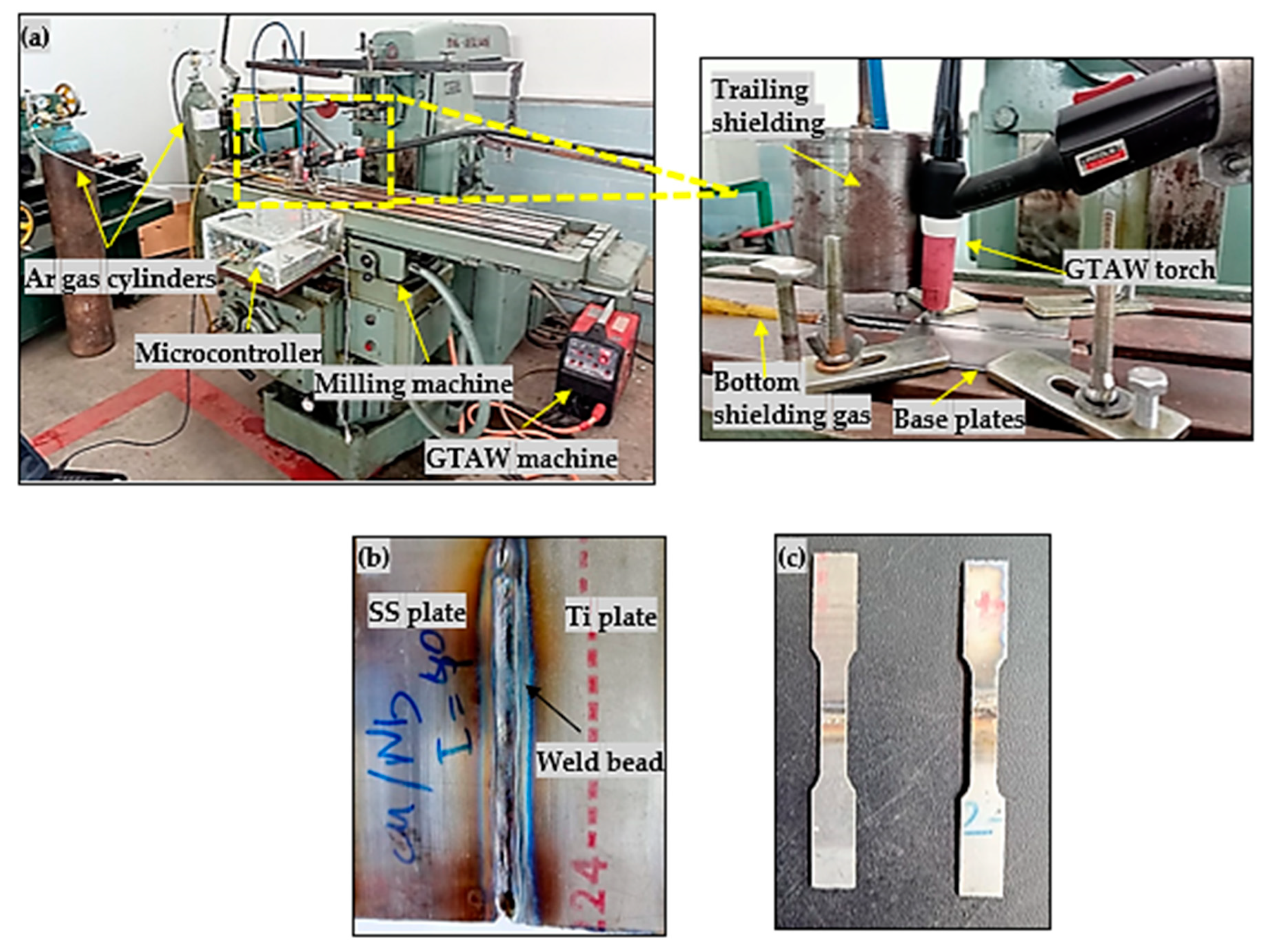Performance Evaluation of Ti and SS Dissimilar GTAW Joints via Non-Destructive Testing Methods †
Abstract
1. Introduction
2. Materials and Methods
3. Results and Discussion
4. Conclusions
Author Contributions
Funding
Institutional Review Board Statement
Informed Consent Statement
Data Availability Statement
Conflicts of Interest
References
- Jawad, M.; Jahanzaib, M.; Ilyas, M. Evaluation of welded joints of dissimilar titanium alloy Ti-5Al-2.5 Sn and stainless-steel 304 at different multi-interlayer modes. Mater. Res. Express 2022, 9, 106501. [Google Scholar] [CrossRef]
- Giri, S.R.; Khamari, B.K.; Moharana, B.R. Joining of titanium and stainless steel by using different welding processes: A review. Mater. Today Proc. 2022, 66, 505–508. [Google Scholar] [CrossRef]
- Jawad, M.; Jahanzaib, M.; Ali, M.A.; Hussain, S.; Ahmad, W.; Ahmed, N. Improvement in mechanical and microstructural properties of novel TA7/Nb/Cu/SS304 composite joints by reducing intermetallic compounds. Int. J. Adv. Manuf. Technol. 2024, 130, 3257–3274. [Google Scholar] [CrossRef]
- Haider, F.; Jahanzaib, M.; Hanif, M.W. Optimizing the process parameters of Fiction Stir Welded dissimilar 2024Al-5754Al Joint using the Taguchi Method. MATEC Web Conf. 2023, 381, 02006. [Google Scholar] [CrossRef]
- Mehdi, H.; Batra, L.; Singh, A.P.; Malla, C. Multi-response optimization of FSW process parameters of dissimilar aluminum alloys of AA2014 and AA6061 by response surface methodology (RSM). Int. J. Interact. Des. Manuf. (IJIDeM) 2024, 18, 1507–1522. [Google Scholar] [CrossRef]
- Jawad, M.; Jahanzaib, M.; Ali, M.A.; Farooq, M.U.; Mufti, N.A.; Pruncu, C.I.; Hussain, S.; Wasim, A. Revealing the microstructure and mechanical attributes of pre-heated conditions for gas tungsten arc welded AISI 1045 steel joints. Int. J. Press. Vessel. Pip. 2021, 192, 104440. [Google Scholar] [CrossRef]
- Hanif, M.W.; Wasim, A.; Sajid, M. Evaluating the Effect of Process Parameters on the Mechanical Properties of an AA7075-Cu Overcast Joint Using the Taguchi Method. Eng. Proc. 2022, 23, 3. [Google Scholar] [CrossRef]
- Subramaniam, S.; Ozevin, D.; Indacochea, E. Characterization of GMAW (Gas Metal Arc Welding) Penetration Using Ultrasonics. Materials 2020, 13, 2307. [Google Scholar] [CrossRef]
- Chassignole, B.; El Guerjouma, R.; Ploix, M.-A.; Fouquet, T. Ultrasonic and structural characterization of anisotropic austenitic stainless steel welds: Towards a higher reliability in ultrasonic non-destructive testing. NDT E Int. 2010, 43, 273–282. [Google Scholar] [CrossRef]
- Deepak, J.; Raja, V.B.; Kaliaraj, G.S. Mechanical and corrosion behavior of Cu, Cr, Ni and Zn electroplating on corten A588 steel for scope for betterment in ambient construction applications. Results Phys. 2019, 14, 102437. [Google Scholar] [CrossRef]
- Taheri, H.; Kilpatrick, M.; Norvalls, M.; Harper, W.J.; Koester, L.W.; Bigelow, T.; Bond, L.J. Investigation of nondestructive testing methods for friction stir welding. Metals 2019, 9, 624. [Google Scholar] [CrossRef]
- Ranganayakulu, S.; Burra, S.G.; Ravi, S. Characterization of Weldments Defects through Non Destructive Evaluation Techniques. Indian J. Sci. Technol. 2017, 10, 1–9. [Google Scholar] [CrossRef][Green Version]
- Frasco-García, O.D.; García-García, V.; Reyes-Calderón, F.; Hernández-Cristóbal, O.; Garnica-González, P. Investigation of weld defects, microstructural, and mechanical features of TWIP and austenitic stainless steel dissimilar joints by pulsed GTAW process. Int. J. Adv. Manuf. Technol. 2022, 119, 6371–6392. [Google Scholar] [CrossRef]
- Vempati, S.; Gopinath, V.; Srinivasulu, M.; Babu, U.H.; Chandrasekhar, K. Experimental investigation on heat treated TI-6AL-4V welded joints based on tribological and non destructive techniques. Int. J. Mech. Eng. 2022, 7, 183–194. [Google Scholar]
- Deepak, J.; Raja, V.B.; Srikanth, D.; Surendran, H.; Nickolas, M. Non-destructive testing (NDT) techniques for low carbon steel welded joints: A review and experimental study. Mater. Today Proc. 2021, 44, 3732–3737. [Google Scholar] [CrossRef]
- Jawad, M.; Jahanzaib, M.; Ali, M.A.; Sajid, M.; Hussain, S. Evaluation of Residual Stresses and Distortion of Ti-5Al-2.5 Sn and SS 304 Gas Tungsten Arc Welded Joints under Hybrid Thermal Tensioning Technique: Transient Thermal Tensioning and Trailing Intensive Cooling. J. Mater. Eng. Perform. 2024, 33, 7564–7576. [Google Scholar] [CrossRef]
- Hanif, M.W.; Wasim, A.; Sajid, M.; Hussain, S.; Jawad, M.; Jahanzaib, M. Evaluation of microstructure and mechanical properties of squeeze overcast Al7075−Cu composite joints. China Foundry 2023, 20, 29–39. [Google Scholar] [CrossRef]
- Hao, X.; Wei, X.; Li, S.; Cui, Z.; Wang, W.; Dong, H.; Li, W. Joining mechanism evolution of fusion welded TC4 titanium alloy/304 stainless steel dissimilar joint by GTAW. Sci. Technol. Weld. Join. 2023, 28, 1031–1040. [Google Scholar] [CrossRef]
- ASTM. Standard test methods for tension testing of metallic materials. In Annual Book of ASTM Standards; ASTM: West Conshohocken, PA, USA, 2001. [Google Scholar]
- Rajeswari, S.; Lakshmi, M.V.; Shubhanjali, M.; Mathew, J.; Raghu, K.; Sreedhar, S. Applications of visual inspection in NDE of aero engine components—Case studies. In Proceedings of the Indian National Seminar & Exhibition on Non-Destructive Evaluation NDE, Virtual, 10–12 December 2020. [Google Scholar]



| Welded Samples | UTS (Value 1) | UTS (Value 2) | UTS (Value 3) | Mean | SD |
|---|---|---|---|---|---|
| Sample A1 | 249 | 253 | 243 | 248.2992 | 4.109609 |
| Sample A2 | 158 | 162 | 161 | 160.3243 | 1.699673 |
Disclaimer/Publisher’s Note: The statements, opinions and data contained in all publications are solely those of the individual author(s) and contributor(s) and not of MDPI and/or the editor(s). MDPI and/or the editor(s) disclaim responsibility for any injury to people or property resulting from any ideas, methods, instructions or products referred to in the content. |
© 2024 by the authors. Licensee MDPI, Basel, Switzerland. This article is an open access article distributed under the terms and conditions of the Creative Commons Attribution (CC BY) license (https://creativecommons.org/licenses/by/4.0/).
Share and Cite
Ali, A.; Jahanzaib, M.; Jawad, M. Performance Evaluation of Ti and SS Dissimilar GTAW Joints via Non-Destructive Testing Methods. Eng. Proc. 2024, 75, 36. https://doi.org/10.3390/engproc2024075036
Ali A, Jahanzaib M, Jawad M. Performance Evaluation of Ti and SS Dissimilar GTAW Joints via Non-Destructive Testing Methods. Engineering Proceedings. 2024; 75(1):36. https://doi.org/10.3390/engproc2024075036
Chicago/Turabian StyleAli, Abid, Mirza Jahanzaib, and Muhammad Jawad. 2024. "Performance Evaluation of Ti and SS Dissimilar GTAW Joints via Non-Destructive Testing Methods" Engineering Proceedings 75, no. 1: 36. https://doi.org/10.3390/engproc2024075036
APA StyleAli, A., Jahanzaib, M., & Jawad, M. (2024). Performance Evaluation of Ti and SS Dissimilar GTAW Joints via Non-Destructive Testing Methods. Engineering Proceedings, 75(1), 36. https://doi.org/10.3390/engproc2024075036






